Mercury
Mercury passes through superior conjunction on November 17th. The smallest planet in the Solar System is currently located on the far side of the Sun and therefore unsuitably placed for observation throughout the month.
On November 25th it reaches aphelion - the point in its orbit when farthest from the Sun - at 0.467 AU (approx. 69.9 million kilometres or 43.4 million miles) distant.
Venus
Venus continues to dominate the early morning sky during November. Although fading slightly from magnitude -4.4 to -4.2 it's still a magnificent sight and easily brighter than all other night sky objects apart from the Moon. From northern temperate latitudes, the planet rises more than 4 hours before the Sun but from the Southern Hemisphere for only about half this time.
The morning sky is currently a treasure trove of planetary activity with Jupiter and Mars also visible. To the naked eye the most obvious difference between the planets is brightness. As already noted, Venus is stunning and easily outshines the rest. Jupiter is also very bright but considerably fainter than Venus while Mars is dim in comparison.
On November 3rd, Venus passes 0.7 degrees south of Mars and acts as a useful guide to locating the "Red planet". Seven degrees northwest of the pair is Jupiter with the last quarter Moon higher still in the sky. Venus then slowly distances itself from Mars as they continue on their southeasterly paths against the background stars.
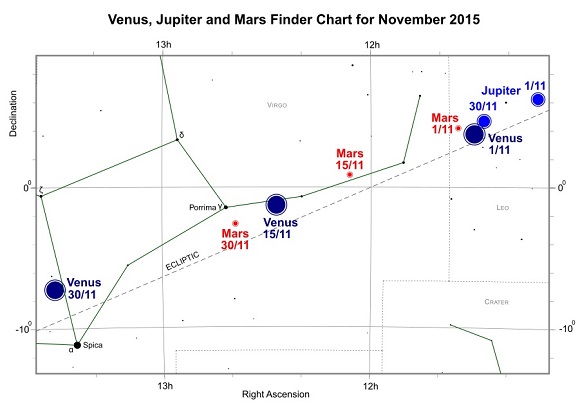
Venus, Jupiter and Mars during November 2015 - pdf format (credit:- freestarcharts)
The waning crescent Moon will be close to Venus and Mars on the morning of November 7th. Later in the month on the 28th, Venus passes 4 degrees north of Spica (α Vir - mag. +1.0). The following day Venus reaches perihelion - the point in its orbit when nearest the Sun - at 0.718 AU (approx. 107 million kilometres or 66.7 million miles) distant.
Mars
Mars remains an early morning object, brightening slightly from magnitude +1.7 to +1.5 as the month progresses. However, the visibility period of the "Red planet" is improving and from northern temperate latitudes it's rises more than 5 hours before the Sun at the end of the month although considerably less for those further south.
Mars starts the month in Leo before crossing into Virgo on November 2nd where it remains for the rest of the month. To the naked eye Mars appears red-orange in colour. It has an apparent size of 4.6 arc seconds and therefore telescopically is currently too small to reveal much surface details.
As mentioned above, Venus passes close by Mars on November 3rd and a nice grouping of Venus, Mars, Jupiter and the crescent Moon occurs on the morning of November 7th.
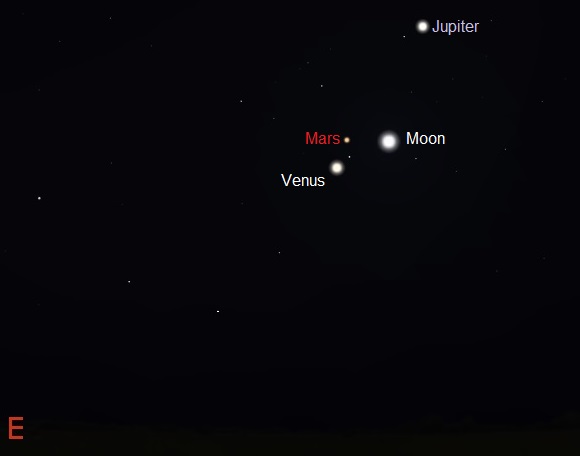
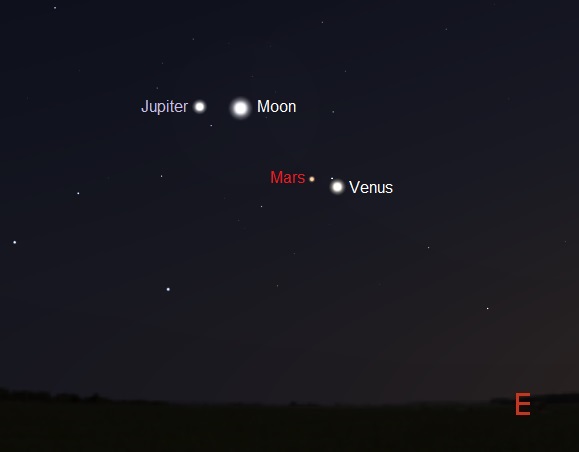
On November 20th, Mars reaches aphelion when it's 1.666 AU (approx. 249.2 million kilometres or 154.9 million miles) from the Sun.
Jupiter
Jupiter like Venus and Mars continues to be visible as a brilliant morning object in the eastern sky. The giant planet brightens from magnitude -1.8 to -2.0 with its apparent size increasing from 33 to 35 arc seconds as November progresses. It's currently located in Leo and on November 6th the waning crescent Moon will make a nice morning pairing with the planet.
By the end of the month, Jupiter rises just after midnight from mid-latitude Northern Hemisphere locations although slightly later for those further south. What's noticeable is how quickly Venus and Mars move away from Jupiter in the sky. All three planets start the month relatively close together but by months end Venus is 30 degrees southeast of Jupiter with Mars more than 15 degrees.
Saturn
Saturn, mag. +0.6, reaches solar conjunction on November 30th. From mid-northern latitudes the planet will not be visible but those at tropical and Southern Hemisphere locations may be able to glimpse it low down above the west-southwest horizon after sunset for the first few days of the month.
Uranus
Uranus now passed opposition but continues to be well placed for observation during November. The seventh planet from the Sun can be seen in Pisces towards the east as soon as it's dark enough and remains observable until the early hours of the morning. Uranus shines at magnitude +5.7 and is faintly visible to the naked eye but much easier to spot with binoculars. A small telescope such as a 80mm (3.1-inch) refractor at high magnifications will show a small greenish disk, but even large amateur scopes don't reveal much more.
Uranus has 27 known most satellites and the biggest four can be seen with amateur scopes. Of these, Titania and Oberon require scopes of at least 200mm (8 inches) aperture. The next two Umbriel and Ariel are more difficult to spot since they are fainter and positioned closer to the planet.
On November 22nd the waxing gibbous Moon passes 0.9 degrees south of Uranus with an occultation visible from the South Indian Ocean at 18:41 UT.
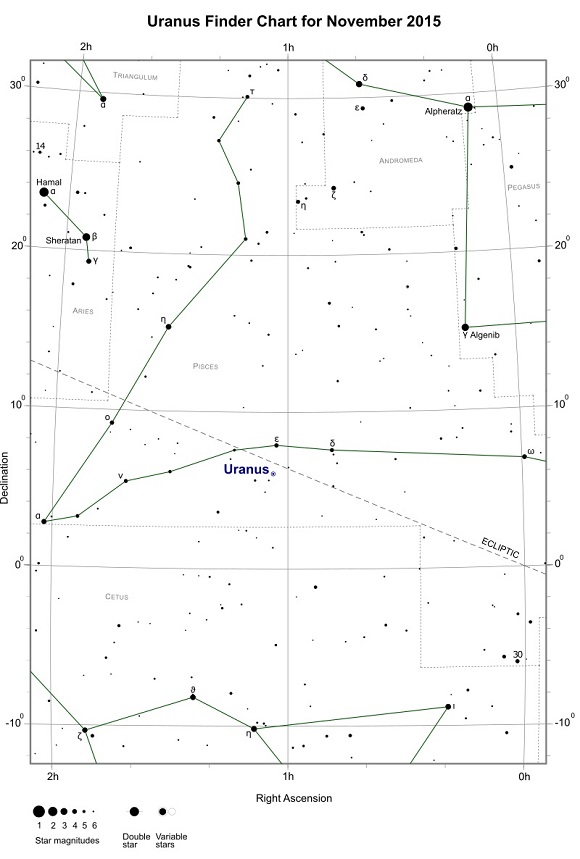
Uranus during November 2015 - pdf format (credit:- freestarcharts)
Neptune
Neptune is located in Aquarius and is visible as soon as it's dark enough and remains so until after midnight. The planet is positioned about 30 degrees southwest of the Great Square of Pegasus and just over a degree northeast of star sigma (σ) Aqr (mag. +4.8).
At magnitude +7.9, Neptune can't be seen with the naked but is relatively easy to find with binoculars, the trick is knowing exactly where to look. Even a small scope at high magnifications will show the planet as a blue disk although with an apparent diameter of only 2.3 arc seconds, it appears very small.
On November 18th the planet reaches its second stationary point, signaling the end of this year's opposition period. It then resumes direct motion. Two days later the first quarter Moon passes 3 degrees north of Neptune.
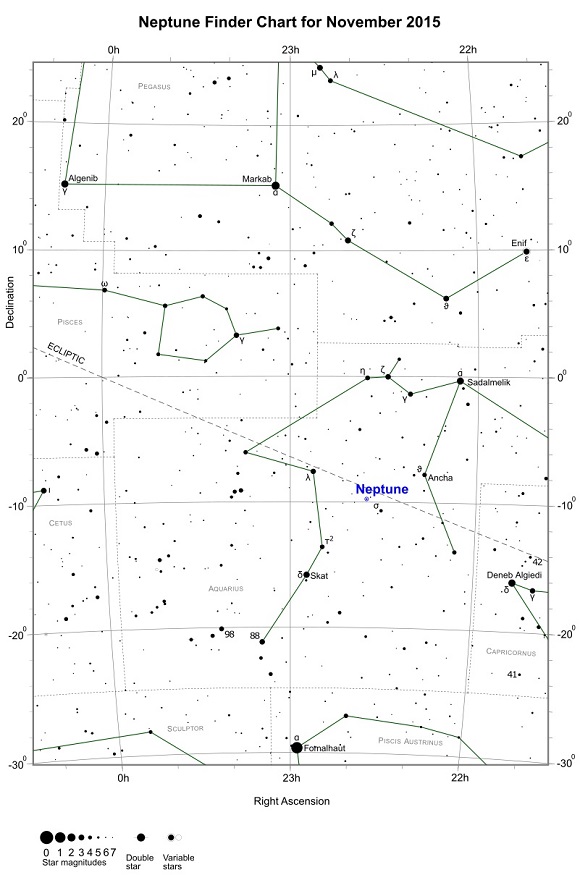
Neptune during November 2015 - pdf format (credit:- freestarcharts)
Solar System Data Table November 2015
| Date | Right Ascension | Declination | Apparent Magnitude | Apparent Size | Illum. (%) | Distance from Earth (AU) | Constellation | |
|---|---|---|---|---|---|---|---|---|
| Sun | 5th Nov 2015 | 14h 38m 21.1s | -15d 26m 35.7s | -26.8 | 32.3' | 100 | 0.992 | Libra |
| Sun | 15th Nov 2015 | 15h 18m 38.8s | -18d 17m 06.5s | -26.8 | 32.3' | 100 | 0.989 | Libra |
| Sun | 25th Nov 2015 | 16h 00m 19.4s | -20d 35m 34.7s | -26.8 | 32.4' | 100 | 0.987 | Scorpius |
| Mercury | 5th Nov 2015 | 14h 09m 35.8s | -11d 51m 19.2s | -1.1 | 04.9" | 97 | 1.369 | Virgo |
| Mercury | 15th Nov 2015 | 15h 12m 26.4s | -17d 50m 23.4s | -1.4 | 04.7" | 100 | 1.439 | Libra |
| Mercury | 25th Nov 2015 | 16h 17m 09.0s | -22d 22m 42.3s | -1.0 | 04.7" | 99 | 1.445 | Scorpius |
| Venus | 5th Nov 2015 | 11h 46m 14.7s | 02d 25m 26.4s | -4.4 | 21.8" | 55 | 0.766 | Virgo |
| Venus | 15th Nov 2015 | 12h 27m 09.2s | -01d 16m 03.6s | -4.3 | 19.9" | 60 | 0.841 | Virgo |
| Venus | 25th Nov 2015 | 13h 09m 25.5s | -05d 13m 25.0s | -4.3 | 18.3" | 64 | 0.914 | Virgo |
| Mars | 5th Nov 2015 | 11h 43m 53.4s | 03d 15m 53.5s | 1.7 | 04.3" | 95 | 2.174 | Virgo |
| Mars | 15th Nov 2015 | 12h 06m 05.5s | 00d 53m 29.9s | 1.6 | 04.5" | 94 | 2.100 | Virgo |
| Mars | 25th Nov 2015 | 12h 28m 02.0s | -01d 27m 08.0s | 1.6 | 04.6" | 94 | 2.019 | Virgo |
| Jupiter | 5th Nov 2015 | 11h 14m 23.7s | 05d 59m 47.4s | -1.8 | 33.3" | 99 | 5.914 | Leo |
| Jupiter | 15th Nov 2015 | 11h 20m 11.4s | 05d 25m 11.7s | -1.9 | 34.1" | 99 | 5.777 | Leo |
| Jupiter | 25th Nov 2015 | 11h 25m 15.6s | 04d 55m 14.1s | -1.9 | 35.0" | 99 | 5.630 | Leo |
| Saturn | 5th Nov 2015 | 16h 10m 40.3s | -19d 21m 52.5s | 0.6 | 15.2" | 100 | 10.913 | Scorpius |
| Saturn | 15th Nov 2015 | 16h 15m 26.8s | -19d 35m 07.2s | 0.6 | 15.2" | 100 | 10.964 | Scorpius |
| Saturn | 25th Nov 2015 | 16h 20m 21.3s | -19d 47m 54.7s | 0.6 | 15.1" | 100 | 10.989 | Scorpius |
| Uranus | 5th Nov 2015 | 01h 05m 00.1s | 06d 11m 49.1s | 5.7 | 03.7" | 100 | 19.075 | Pisces |
| Uranus | 15th Nov 2015 | 01h 03m 45.0s | 06d 04m 21.7s | 5.7 | 03.7" | 100 | 19.162 | Pisces |
| Uranus | 25th Nov 2015 | 01h 02m 42.3s | 05d 58m 12.3s | 5.7 | 03.7" | 100 | 19.273 | Pisces |
| Neptune | 5th Nov 2015 | 22h 35m 32.1s | -09d 44m 57.1s | 7.9 | 02.3" | 100 | 29.531 | Aquarius |
| Neptune | 15th Nov 2015 | 22h 35m 20.9s | -09d 45m 52.6s | 7.9 | 02.3" | 100 | 29.694 | Aquarius |
| Neptune | 25th Nov 2015 | 22h 35m 22.4s | -09d 45m 31.9s | 7.9 | 02.3" | 100 | 29.864 | Aquarius |